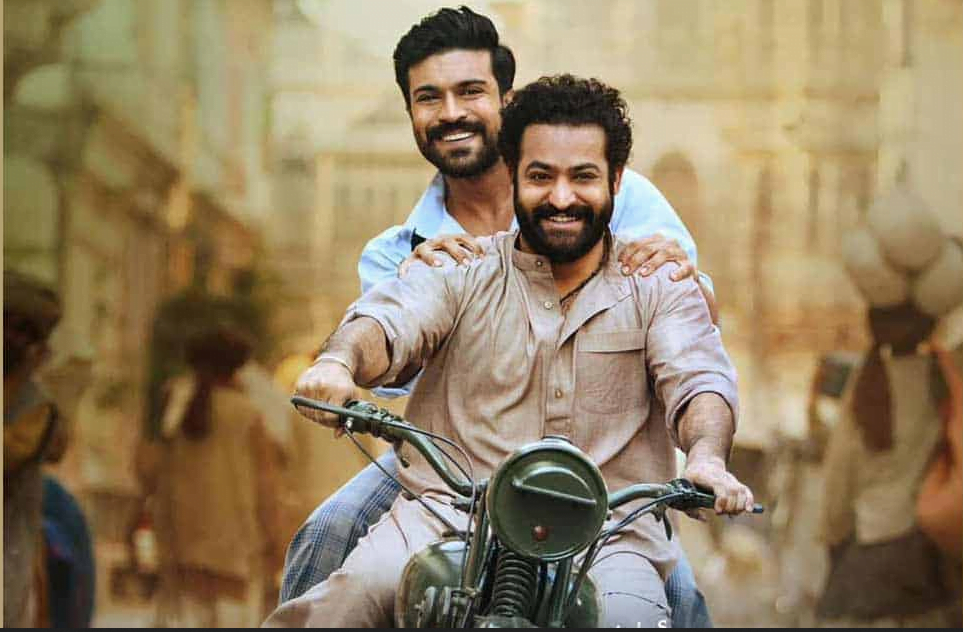Sitting for the SS Rajamouli’s eagerly-anticipated spectacle RRR was an experience. This reviewer sat down in a packed theatre in Hyderabad for a 7AM show. Hoping to give proper attention and note on the theme and consistencies. But this epic which has been created and visualised manages to pull you in for the most outlandish premises one can conjure on. By the time, the pre-interval sequences begin, a very excited person spilt his popcorn on me but I was also too busy being stunned for the images unfolding on the big screen.
Malli, a girl from the Gond Tribe is forcibly taken away from her family and taken to the British Governor’s house in Delhi. Komaram Bheem is on the task to bring her back home. In Delhi, Rama Raju, a police officer under the British has secret ambitions of his own. He takes up the responsibility to capture Bheem who is said to be a threat to the Governor. The two men are set up as rivals although they are not aware of it.
RRR can be classified as historical fiction. The makers ask a question what if these two real-life freedom fighters, icons of the region had met and weaved out a tale where the question of personal and political melds. Rajamouli amps it up with good old masala cinema taking in a lot of inspiration from the Hindu epics.
Two men on two different missions presented in duality. There’s NTR Jr, who is expressed as water which either quenches one’s needs and aspirations or can cause havoc. And there’s Ram played by Ram Charan who is personified by fire. Who has a raging fire waiting to extinguish something for the end goal but can also turn into a guiding light spreading warmth when needed. The film works thanks to the bonhomie present between the two heroes, although I wished it was explored more.
Alluri Sitarama Raju is modelled after Lord Ram. He uses a bow and arrows, has a fiancee named Sita eagerly waiting for him, is away from home for years to fulfil a mission. While Komaram Bheem is like Bheem from the Mahabharata who has the power to battle with a tiger and lifts motorcycles effortlessly. One character calls the British empire as Lanka and there’s a sort of reversal with a key event in Ramayana that happens in the movie.
The many set pieces strike the audience well thanks to the strong emotional core built into it. Music by M.M Keeravani, especially Nattu Nattu which was a patriotic dance-off garnered some of the loudest cheers and Komouram Bheemano which evokes strong emotions support the actions in the film. The cinematography by K.K Senthil Kumar and the editing by A. Sreekar Prasad is top-notch that you would have not realised you sat for a three-hour film.
However, the film suffers due to the presence of a few tropes, the various British characters who were caricatured, shoving the Adivasi issues under a carpet and very few details given regarding the Nizam. The movie also has a weaker villain as opposition even though the film tries to pitch General Scott (Ray Stevenson) and Lady Scott (Alisson Dhody), as evil personified, it just wasn’t enough. The first half which had built up the momentum finishes with an electrifying pre-interval sequences while the second half gets hit with doses of melodrama. Even the climax sequences did not have the spunk which were seen in earlier stunts.
Perhaps the only time I remembered Baahubali was when I noticed how the female characters were not utilised at all in RRR unlike the former which gave more depth to the plot. Olivia Morris as Jenny plays the kind-hearted British woman seen in every Indian film. Alia Bhatt as Sita has a blink and miss appearance in the film. The persona of Ajay Devgn while contributing to the gravitas required for the role is affected due to lip-sync in Telugu and slows the film down.
What was my favourite sequence is when a character realises that guns are not the only weapons needed for rebellion. And, the character through a song realises that anything can be a weapon, from legs to a song. The camera pans upon the one inflicting wounds and it lingers on as you see the transformation is unfolding. This crucial sequence sets up for the third act of the film
Does RRR provide you with an outrageous spectacle, it certainly delivers on that aspect. But when a film deals with the lives of two iconic revolutionaries from Telangana and Andhra, should Rajamouli have taken so many creative liberties?
In a scene, Bheem says “I’m just a tribal who came in search of Malli, I didn’t understand his (Ramaraju’s) struggle for this land”. The film reduces the larger role the leader had played for Adivasi rights. Even his slogan, ‘Jal, Jangal, Zameen’ (Water, Forest, Land) makes a token appearance only at the end and the credits song. Alluri Sitarama Raju is embodied as Lord Ram, dressed in saffron and wearing the janeu. The legend who was involved in the fight for Adivasi rights as well ends up being glossed over the image of the god. Their political ideology and the principles they stood over ultimately gets watered down and their true ideals would further be distorted.
As the end credit song rolled and I walked out with different fans excitedly describing the exhilaration they felt in various sequences. I thought about how energising Naatu Naatu and how mind-blowing the pre-interval sequences were on screen and removed one kernel of popcorn, and few bits of paper that had gone inside my shirt.
Thinking on, Was RRR just a set of some brilliant set pieces building up towards a narrative or a half-hearted attempt to create an Indian epic? However, S S Rajamouli once again provides that collective experience one enjoys only inside the theatre but is it a meaningful one is a question to be answered another day.





















































































